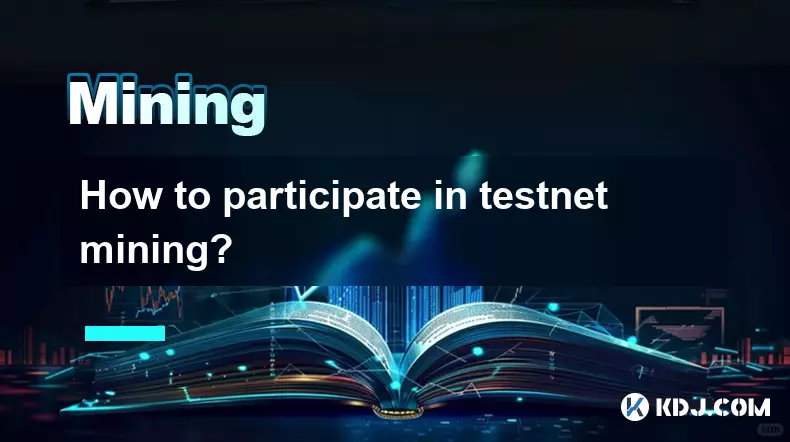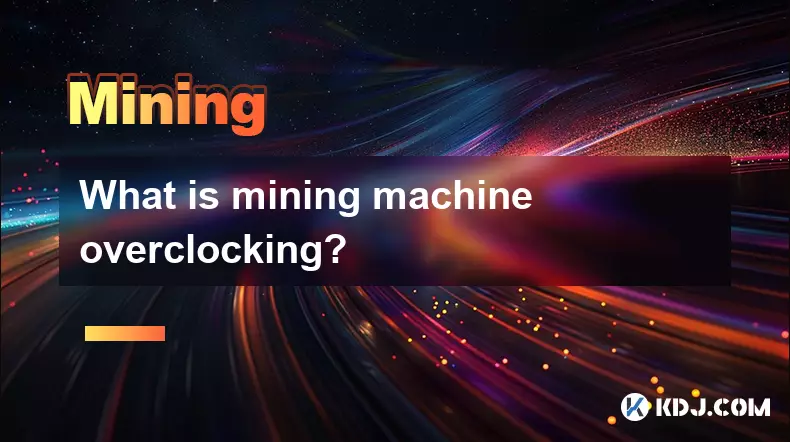-
 bitcoin
bitcoin $109523.663807 USD
-0.13% -
 ethereum
ethereum $4019.526508 USD
2.06% -
 tether
tether $1.000482 USD
0.00% -
 xrp
xrp $2.776815 USD
0.18% -
 bnb
bnb $958.942396 USD
0.12% -
 solana
solana $204.294698 USD
3.84% -
 usd-coin
usd-coin $0.999693 USD
0.00% -
 dogecoin
dogecoin $0.232115 USD
2.09% -
 tron
tron $0.338028 USD
0.84% -
 cardano
cardano $0.790920 USD
1.50% -
 hyperliquid
hyperliquid $44.871443 USD
5.60% -
 ethena-usde
ethena-usde $1.000322 USD
0.04% -
 chainlink
chainlink $21.034165 USD
2.60% -
 avalanche
avalanche $28.794831 USD
-0.54% -
 stellar
stellar $0.360466 USD
1.24%
How to cool a mining rig to prevent overheating?
Proper cooling is essential for mining rig performance and longevity, preventing overheating, throttling, and hardware damage.
Aug 11, 2025 at 10:43 pm

Understanding the Importance of Cooling in Mining Rigs
Maintaining optimal temperature in a mining rig is critical to ensuring sustained performance and hardware longevity. Cryptocurrency mining involves continuous computational processing, which generates substantial heat output from GPUs, ASICs, and power supplies. Without proper cooling, components can suffer from thermal throttling, reduced efficiency, or permanent damage. High temperatures also increase the risk of system crashes and downtime, directly impacting mining profitability. Therefore, implementing effective cooling strategies is not optional—it's essential for operational stability.
Optimizing Airflow in Your Mining Setup
One of the most effective ways to cool a mining rig is through proper airflow management. This begins with the physical layout of the rig and its surrounding environment. Ensure that the mining rig is placed in a well-ventilated area, away from walls or enclosed spaces that restrict air movement. Use open-air frames designed for mining to allow unrestricted airflow around each component.
- Install intake fans at the front or bottom of the rig to pull in cool air.
- Position exhaust fans at the rear or top to expel hot air efficiently.
- Maintain a positive pressure setup by ensuring intake airflow slightly exceeds exhaust, which helps prevent dust buildup.
- Avoid fan configurations that create turbulence or recirculation of hot air.
Regularly clean the fans and filters to prevent dust accumulation, which can insulate components and reduce cooling efficiency. Dust acts as a thermal barrier, so a clean system runs cooler and more reliably.
Choosing the Right Cooling Hardware
Selecting appropriate cooling hardware significantly impacts a rig’s thermal performance. While most mining GPUs come with factory-installed air coolers, upgrading to higher-performance variants can yield noticeable improvements.
- Replace stock fans with high-static pressure fans designed for radiators or heatsinks.
- Consider blower-style coolers for multi-GPU setups, as they exhaust heat directly out the back of the card.
- Use larger fans (120mm or 140mm) where possible, as they move more air at lower RPMs, reducing noise and wear.
For ASIC miners, ensure the built-in cooling system is unobstructed and functioning correctly. Some advanced users retrofit ASICs with custom heatsinks or additional fans for improved heat dissipation. Always verify compatibility before installing third-party cooling components.
Implementing Environmental Cooling Measures
The ambient temperature of the mining environment plays a major role in overall thermal management. Even the best internal cooling cannot compensate for a hot room.
- Place the mining rig in a cooler part of the building, such as a basement or dedicated utility room.
- Use room air conditioning or portable AC units to maintain ambient temperatures below 25°C (77°F).
- Install exhaust ducts to vent hot air outside, especially in enclosed spaces.
- Monitor room temperature with a digital hygrometer to track conditions in real time.
Avoid placing rigs near heat sources like furnaces, water heaters, or direct sunlight. In warmer climates, consider operating rigs during cooler hours or using evaporative coolers if humidity levels allow.
Using Software to Monitor and Control Temperatures
Hardware cooling is only half the solution—software tools provide visibility and control over thermal performance. Most mining operating systems, such as HiveOS, RaveOS, or SimpleMiner, include built-in temperature monitoring and fan control features.
- Access the web dashboard of your mining OS to view real-time GPU and ASIC temperatures.
- Set custom fan curves so that fans increase speed gradually as temperature rises.
- Configure thermal shutdown thresholds to automatically power down the rig if temperatures exceed safe limits (e.g., 85°C for GPUs).
- Use MSI Afterburner (for Windows-based rigs) to fine-tune GPU fan speeds and power limits.
Regularly review temperature logs to identify patterns, such as overheating during peak load times. Adjust fan curves or reduce overclocking settings if temperatures consistently approach critical levels.
Advanced Cooling Techniques for High-Density Setups
For large-scale or high-performance mining operations, standard air cooling may be insufficient. Advanced techniques can be employed to manage heat more effectively.
- Immersion cooling involves submerging entire rigs in a non-conductive liquid, such as dielectric fluid, which absorbs and transfers heat far more efficiently than air. This method eliminates dust and noise while maintaining extremely stable temperatures.
- Water cooling kits designed for GPUs can be installed to replace air coolers. These require careful setup, including water blocks, pumps, radiators, and reservoirs, but offer superior thermal performance.
- Heat exchangers can be used in conjunction with exhaust systems to transfer heat from the mining area to another location.
These methods require higher upfront investment and technical expertise but are justified in environments where space, noise, or heat density are major concerns.
Frequently Asked Questions
Q: Can I use household fans to cool my mining rig?Yes, household fans can supplement cooling by improving room airflow. Position them to blow across the rig or toward exhaust vents. However, they should not replace dedicated case or GPU fans, as they lack the static pressure needed for effective component cooling. Use them as auxiliary tools in conjunction with proper internal airflow.
Q: What is the ideal operating temperature for a mining GPU?The ideal temperature range for most mining GPUs is between 60°C and 75°C under load. Temperatures above 80°C should be addressed immediately, as prolonged exposure can shorten component lifespan. NVIDIA and AMD generally specify maximum safe temperatures around 90°C, but sustained operation near this limit is not recommended.
Q: Does undervolting help reduce heat in mining rigs?Yes, undervolting reduces the power delivered to the GPU, which directly lowers heat output while maintaining or even improving efficiency. This is achieved by adjusting voltage and clock speed settings via tools like MSI Afterburner or through the mining OS. Proper undervolting can reduce temperatures by 10–15°C without sacrificing hashrate.
Q: How often should I clean my mining rig to maintain cooling efficiency?Clean your rig every 2 to 4 weeks depending on dust levels in your environment. Use compressed air to blow dust from fans, heatsinks, and power supplies. For heavily dusted systems, power down the rig and disassemble components for thorough cleaning. Regular maintenance prevents thermal buildup and ensures consistent cooling performance.
Disclaimer:info@kdj.com
The information provided is not trading advice. kdj.com does not assume any responsibility for any investments made based on the information provided in this article. Cryptocurrencies are highly volatile and it is highly recommended that you invest with caution after thorough research!
If you believe that the content used on this website infringes your copyright, please contact us immediately (info@kdj.com) and we will delete it promptly.
- XRP, Bitcoin Price Predictions: Decoding the Crypto Crossroads
- 2025-09-28 08:25:12
- ChatGPT, Crypto, and Crystal Balls: Predictions for a Wild 2025
- 2025-09-28 08:45:12
- Crypto Clash: Can Kaspa and Pi Coin Compete in a Remittix World?
- 2025-09-28 08:45:12
- Riding the Floki Wave: Gauging Gains with Social Engagement and Bottom Signals
- 2025-09-28 08:25:12
- Crypto 2025: MoonBull Charges Ahead, Leaving Pepe and Mog in the Dust
- 2025-09-28 08:50:12
- Sui Price, Toncoin Developments, Remittix ICO: What's the Buzz?
- 2025-09-28 08:50:12
Related knowledge

The difference between staking and mining
Sep 24,2025 at 05:18am
Understanding Staking in the Cryptocurrency Ecosystem1. Staking involves holding funds in a cryptocurrency wallet to support the operations of a block...

How to participate in testnet mining?
Sep 22,2025 at 09:18am
Understanding Testnet Mining in the Crypto Ecosystem1. Testnet mining is a method used by blockchain developers to simulate real-world conditions on a...

How to dispose of abandoned mining machines?
Sep 19,2025 at 08:19pm
Assessing the Condition of Abandoned Mining Rigs1. Begin by inspecting each mining machine for visible damage, corrosion, or missing components. Machi...

How to identify high-quality mining pools?
Sep 21,2025 at 03:19pm
Reputation and Track Record1. A mining pool’s reputation is built over time through consistent performance and transparency. Pools that have operated ...

Advantages of decentralized mining pools
Sep 20,2025 at 04:36pm
Enhanced Security and Resistance to Censorship1. Decentralized mining pools operate on blockchain-based smart contracts, eliminating the need for a ce...

What is mining machine overclocking?
Sep 21,2025 at 07:19pm
Understanding Mining Machine Overclocking1. Mining machine overclocking refers to the process of increasing the operating frequency of a cryptocurrenc...

The difference between staking and mining
Sep 24,2025 at 05:18am
Understanding Staking in the Cryptocurrency Ecosystem1. Staking involves holding funds in a cryptocurrency wallet to support the operations of a block...

How to participate in testnet mining?
Sep 22,2025 at 09:18am
Understanding Testnet Mining in the Crypto Ecosystem1. Testnet mining is a method used by blockchain developers to simulate real-world conditions on a...

How to dispose of abandoned mining machines?
Sep 19,2025 at 08:19pm
Assessing the Condition of Abandoned Mining Rigs1. Begin by inspecting each mining machine for visible damage, corrosion, or missing components. Machi...

How to identify high-quality mining pools?
Sep 21,2025 at 03:19pm
Reputation and Track Record1. A mining pool’s reputation is built over time through consistent performance and transparency. Pools that have operated ...

Advantages of decentralized mining pools
Sep 20,2025 at 04:36pm
Enhanced Security and Resistance to Censorship1. Decentralized mining pools operate on blockchain-based smart contracts, eliminating the need for a ce...

What is mining machine overclocking?
Sep 21,2025 at 07:19pm
Understanding Mining Machine Overclocking1. Mining machine overclocking refers to the process of increasing the operating frequency of a cryptocurrenc...
See all articles










































































